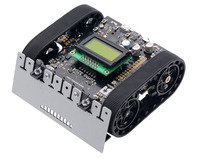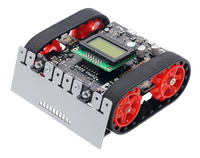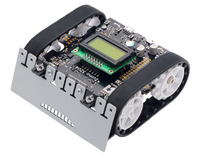POLOLU
Zumo Robot Kit for Arduino, v1.2 (No Motors)
Zumo Robot Kit for Arduino, v1.2 (No Motors)
SKU:Pololu-2509
Couldn't load pickup availability
Share
This kit contains most of the parts you need to build an Arduino-controlled Zumo robot. It consists of a Zumo Shield for Arduino, v1.2, a Zumo chassis kit, and a Zumo blade. You will also need a pair of micro metal gearmotors, four AA batteries, and an A-Star 32U4 Prime or Arduino to complete your Zumo robot (motors, batteries, and Arduino sold separately). This product is a kit; assembly (including soldering) is required.
Note: This product is a kit; assembly (including soldering) is required. Motors, batteries, and Arduino are sold separately. An assembled version is available that does not require any assembly or soldering and includes motors and a Zumo reflectance sensor array.
Kit Contents
- One Zumo Shield for Arduino, v1.2
- One Zumo chassis kit
- One Zumo blade
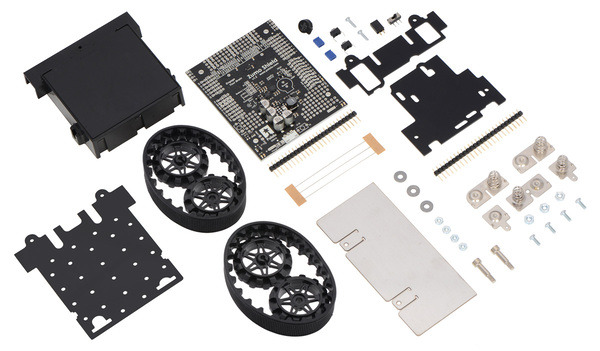 |
|
Contents of the Zumo robot kit for Arduino, v1.2. |
|---|
Please see the specific pages for those products for more information about them, assembly instructions, and links to related resources. The only difference between this and the previous Zumo Robot kit version is the inclusion of a v1.2 Zumo shield in place of the previous shield version. The only changes to the shield are an upgrade of the integrated accelerometer/magnetometer IC and the addition of a 3-axis gyroscope.
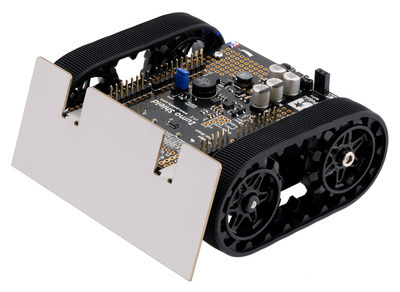 |
|
Zumo Robot for Arduino, v1.2. |
|---|
July 10, 2015 update: This kit now includes black, spoked sprockets (see the main product picture) in place of the original white ones (which can still be seen in some of the pictures on this page).
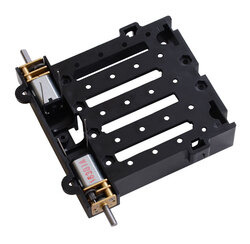 |
|
Zumo chassis being assembled with two micro metal gearmotors. |
|---|
Required Accessories (not included)
- Two micro metal gearmotors. These gearmotors are available in several power options and a wide variety of gear ratios, allowing for a customizable combination of torque and speed. The Zumo Shield can deliver enough power for all of the micro metal gearmotors we carry, including the high-power (HP) versions. Note that some gear ratios are better suited for the Zumo than others; please see the Zumo chassis kit product page for specific motor suggestions.
- Four AA batteries. The Zumo chassis works with both alkaline and NiMH batteries, though we recommend rechargeable NiMH cells.
- An Arduino or compatible control board. The Zumo Shield works with the A-Star 32U4 Prime, Arduino Uno and Arduino Leonardo. It is not compatible with the Arduino Mega or Due, but it can be used with older Arduinos that have the same form factor as the Uno, such as the Duemilanove. (Other Arduino-compatible controllers might work with the Zumo robot, but support for them will be limited and they might require modification; for example, one customer got his Zumo robot working with the Freescale FRDM-KL25Z board.)
Optional Accessories
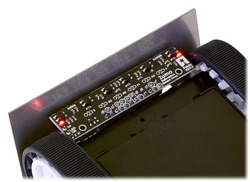 |
|
Zumo reflectance sensor array on a Zumo robot, bottom view. |
|---|
- Zumo reflectance sensor array. This sensor bar mounts along the front edge of the Zumo shield and allows the Zumo to detect features on the ground in front of it, such as lines for following or edges for avoiding (such as the rim of a sumo ring or the edge of a table). It is designed specifically for use with the Zumo shield.
- iMAX-B6AC battery charger for charging the Zumo’s battery’s through the Zumo Shield’s 2-pin charge port. Note that you only need a battery charger if you plan on powering the Zumo with rechargeable cells, and that charger should be capable of charging 4 NiMH cells in series. Alternatively, since the Zumo just uses ordinary AA batteries, you can use AA chargers (into which you stick the individual cells) available at most general electronics stores.
- Optical rangefinders for obstacle/opponent detection.
- Connectors (headers, jumper wires, etc) for adding more sensors.
- Replacement sprockets in red or white. The Zumo robot for Arduino includes the black sprockets shown in the left picture below, but other colors can be purchased separately if you want to add a bit of personalization to your robot. The following pictures show the newer Zumo 32U4 Robot, which is based on the same Zumo chassis and therefore uses the same sprockets:
|
|
|
Comparison with the Zumo 32U4 robot
The newer Zumo 32U4 is another robot based on the Zumo chassis. It is a more highly integrated robot than the Zumo robot for Arduino, with enhancements that include a built-in Arduino-compatible ATmega32U4 microcontroller (the same one used in the Arduino Leonardo and A-Star 32U4 boards), an LCD, encoders for closed-loop motor control, and proximity sensors for obstacle detection. The Zumo 32U4 main board effectively combines the functions of the Zumo Shield and the separate Arduino controller into a single, compact board that is just as easy to program as a standard Arduino or A-Star thanks to its USB interface and preloaded Arduino-compatible bootloader.
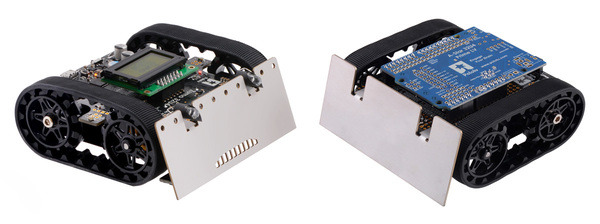 |
|
A Zumo 32U4 robot (left) and a Zumo robot for Arduino with an A-Star 32U4 Prime LV (right). |
|---|
Some of the pin mappings and software libraries differ between the Zumo 32U4 and Zumo robot for Arduino, so programs written for one robot generally need to be modified to work on the other.





New Products
-
Conductivity Calibration K 1.0 Set (4 pouches)
Vendor:Atlas ScientificRegular price Rs. 1,599.00Regular priceUnit price / per -
Analog Discovery 3 Pro Bundle
Vendor:DigilentRegular price Rs. 42,569.00Regular priceUnit price / per -
Lighthouse swarm bundle - Crazyflie 2.1+ (250mAh batteries)
Vendor:BitcrazeRegular price Rs. 474,999.00Regular priceUnit price / per -
Loco Swarm bundle - Crazyflie 2.1+ (250mAh batteries)
Vendor:BitcrazeRegular price Rs. 544,999.00Regular priceUnit price / per -
Kopis X8 Cinelifter 5" Kit - Caged (Frame Kit)
Vendor:HolybroRegular price Rs. 28,199.00Regular priceUnit price / per -

 Sold out
Sold outAtlas Scientific i3 InterLink
Vendor:Atlas ScientificRegular price Rs. 6,349.00Regular priceUnit price / per -

 Sold out
Sold outPoE Injector
Vendor:LuxonisRegular price Rs. 2,099.00Regular priceUnit price / per -

 Sold out
Sold out1-Port VINT Hub Phidget
Vendor:PhidgetsRegular price Rs. 2,699.00Regular priceUnit price / per -
ACS37220LEZATR-100B3 Current Sensor Large Carrier -100A to +100A, 3.3V
Vendor:POLOLURegular price Rs. 829.00Regular priceUnit price / per -
CT433-HSWF50MR TMR Current Sensor Compact Carrier -50A to +50A, 3.3V
Vendor:POLOLURegular price Rs. 1,039.00Regular priceUnit price / per -
A5984 Stepper Motor Driver Carrier, Adjustable Current, Blue Edition
Vendor:POLOLURegular price Rs. 409.00Regular priceUnit price / per -


A5984 Stepper Motor Driver Carrier, Fixed 1A@5V / 660mA@3.3V, Blue Edition (Soldered Header Pins)
Vendor:POLOLURegular price Rs. 489.00Regular priceUnit price / per -
A5984 Stepper Motor Driver Carrier, Fixed 500mA@5V / 330mA@3.3V (Soldered Header Pins)
Vendor:POLOLURegular price Rs. 469.00Regular priceUnit price / per -
 Sold out
Sold outT Connector Male-Female Pair
Vendor:POLOLURegular price Rs. 169.00Regular priceUnit price / per -
Pololu Reverse Voltage Protector, 4-60V, 10A
Vendor:POLOLURegular price Rs. 159.00Regular priceUnit price / per -
Pololu Reverse Voltage Protector, 4-60V, 12A
Vendor:POLOLURegular price Rs. 199.00Regular priceUnit price / per -
Pololu Ideal Diode Reverse Voltage Protector, 4-60V, 10A
Vendor:POLOLURegular price Rs. 179.00Regular priceUnit price / per -
Pololu Ideal Diode Reverse Voltage Protector, 4-60V, 12A
Vendor:POLOLURegular price Rs. 229.00Regular priceUnit price / per -
Pololu Mini Plastic Gearmotor Bracket Pair - Tall
Vendor:POLOLURegular price Rs. 599.00Regular priceUnit price / per -
Ribbon Cable with Pre-Crimped Terminals 10-Color M-F 6" (15 cm)
Vendor:POLOLURegular price Rs. 149.00Regular priceUnit price / per -
Ribbon Cable with Pre-Crimped Terminals 10-Color M-F 12" (30 cm)
Vendor:POLOLURegular price Rs. 279.00Regular priceUnit price / per -
Wires with Pre-Crimped Terminals 10-Pack M-F 6"
Vendor:POLOLURegular price Rs. 339.00Regular priceUnit price / per -
Ribbon Cable Premium Jumper Wires 10-Color M-M 6" (15 cm)
Vendor:POLOLURegular price Rs. 209.00Regular priceUnit price / per -
Ribbon Cable Premium Jumper Wires 10-Color F-F 6" (15 cm)
Vendor:POLOLURegular price Rs. 209.00Regular priceUnit price / per -
Ribbon Cable Premium Jumper Wires 10-Color M-F 6" (15 cm)
Vendor:POLOLURegular price Rs. 209.00Regular priceUnit price / per






